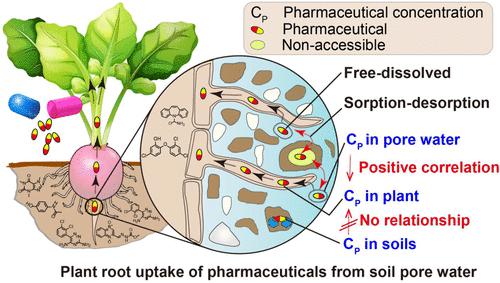当前位置:
X-MOL 学术
›
Environ. Sci. Technol.
›
论文详情
Our official English website, www.x-mol.net, welcomes your feedback! (Note: you will need to create a separate account there.)
Characterization of Plant Accumulation of Pharmaceuticals from Soils with Their Concentration in Soil Pore Water
Environmental Science & Technology ( IF 11.4 ) Pub Date : 2022-06-23 , DOI: 10.1021/acs.est.2c00303 Yuanbo Li 1, 2 , Jonathan Brett Sallach 2, 3 , Wei Zhang 2 , Stephen A Boyd 2 , Hui Li 2
Environmental Science & Technology ( IF 11.4 ) Pub Date : 2022-06-23 , DOI: 10.1021/acs.est.2c00303 Yuanbo Li 1, 2 , Jonathan Brett Sallach 2, 3 , Wei Zhang 2 , Stephen A Boyd 2 , Hui Li 2
Affiliation

|
Predicting plant uptake of pharmaceuticals from soils is very challenging because many pharmaceuticals are ionizable compounds, which experience highly variable sorption/desorption and transformation processes in soils. This study aimed to elucidate how the equilibrium between sorbed and dissolved phases influences radish uptake of 15 pharmaceuticals from three soils with different properties. After 30 days of uptake, the accumulation of acetaminophen, carbamazepine, lamotrigine, carbadox, trimethoprim, and triclosan in radish ranked as Riddles > Capac > Spinks soil. In contrast, radish accumulation of caffeine, lincomycin, monensin, tylosin, sulfadiazine, and sulfamethoxazole exhibited the opposite order of Riddles < Capac < Spinks soil. Oxytetracycline and estrone demonstrated similar accumulation in radish grown in the three soils. Accumulation of pharmaceuticals in radish demonstrated no apparent relation with their concentration in soils. However, we identified strong positive correlation between pharmaceutical accumulation in radish and their corresponding concentration in soil pore water. These results reveal that pharmaceutical in soil pore water is the dominant fraction bioavailable to plant uptake. Relatively constant root concentration factors (RCFs) on the basis of pharmaceutical concentration in soil pore water, compared to the highly variable RCFs derived from soils, suggest that pore water-based RCF is superior for describing pharmaceutical accumulation in plants grown in soils. We recommend that pharmaceuticals in soil pore water should be evaluated and included in modeling their uptake by plants.
中文翻译:

土壤孔隙水中药物浓度的植物积累表征
预测植物从土壤中吸收药物非常具有挑战性,因为许多药物是可离子化的化合物,它们在土壤中经历高度可变的吸附/解吸和转化过程。本研究旨在阐明吸附相和溶解相之间的平衡如何影响萝卜从三种不同性质的土壤中吸收 15 种药物。吸收30天后,萝卜中对乙酰氨基酚、卡马西平、拉莫三嗪、卡巴多、甲氧苄氨嘧啶和三氯生的积累顺序为Riddles > Capac > Spinks土壤。相比之下,萝卜的咖啡因、林可霉素、莫能菌素、泰乐菌素、磺胺嘧啶和磺胺甲恶唑的积累呈现出相反的Riddles < Capac < Spinks土壤的顺序。土霉素和雌酮在三种土壤中生长的萝卜中表现出相似的积累。萝卜中的药物积累与土壤中的浓度没有明显关系。然而,我们发现萝卜中的药物积累与其在土壤孔隙水中的相应浓度之间存在强正相关。这些结果表明,土壤孔隙水中的药物是植物吸收的主要生物可利用部分。与来自土壤的高度可变的 RCF 相比,基于土壤孔隙水中药物浓度的相对恒定的根浓度因子 (RCF) 表明基于孔隙水的 RCF 更适合描述土壤中生长的植物的药物积累。我们建议对土壤孔隙水中的药物进行评估,并将其纳入植物吸收模型中。
更新日期:2022-06-23
中文翻译:

土壤孔隙水中药物浓度的植物积累表征
预测植物从土壤中吸收药物非常具有挑战性,因为许多药物是可离子化的化合物,它们在土壤中经历高度可变的吸附/解吸和转化过程。本研究旨在阐明吸附相和溶解相之间的平衡如何影响萝卜从三种不同性质的土壤中吸收 15 种药物。吸收30天后,萝卜中对乙酰氨基酚、卡马西平、拉莫三嗪、卡巴多、甲氧苄氨嘧啶和三氯生的积累顺序为Riddles > Capac > Spinks土壤。相比之下,萝卜的咖啡因、林可霉素、莫能菌素、泰乐菌素、磺胺嘧啶和磺胺甲恶唑的积累呈现出相反的Riddles < Capac < Spinks土壤的顺序。土霉素和雌酮在三种土壤中生长的萝卜中表现出相似的积累。萝卜中的药物积累与土壤中的浓度没有明显关系。然而,我们发现萝卜中的药物积累与其在土壤孔隙水中的相应浓度之间存在强正相关。这些结果表明,土壤孔隙水中的药物是植物吸收的主要生物可利用部分。与来自土壤的高度可变的 RCF 相比,基于土壤孔隙水中药物浓度的相对恒定的根浓度因子 (RCF) 表明基于孔隙水的 RCF 更适合描述土壤中生长的植物的药物积累。我们建议对土壤孔隙水中的药物进行评估,并将其纳入植物吸收模型中。


























 京公网安备 11010802027423号
京公网安备 11010802027423号